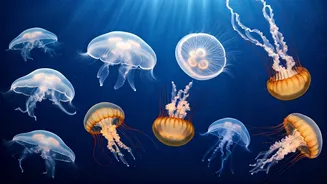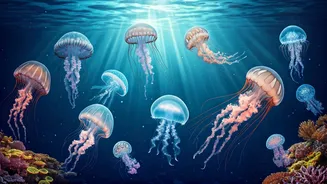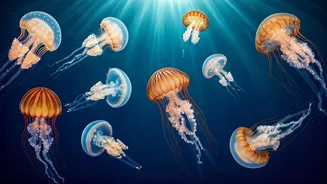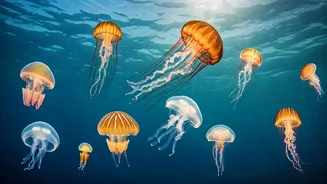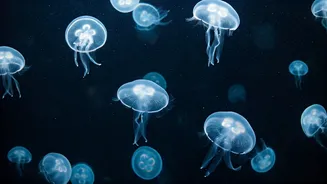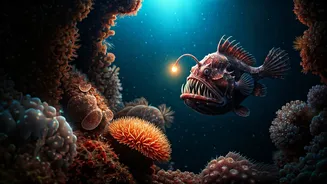The Moon Jelly
The Moon Jellyfish, also known scientifically as Aurelia aurita, is one of the most widely recognized jellyfish species across the globe. These transparent,
saucer-shaped creatures can be found in oceans worldwide, showcasing a delicate beauty with their near-translucent bodies. They typically reach about 25 to 40 centimeters in diameter, displaying a subtle coloration that can vary from clear to pale shades of blue or pink. Their bell shape is marked by four horseshoe-shaped gonads, which are easily visible through the translucent body. Moon Jellies primarily feed on plankton, which they capture using their stinging tentacles. Reproduction involves both sexual and asexual phases, contributing to their widespread abundance in diverse marine environments. They are relatively harmless to humans, with their stings often causing minimal irritation. These jellies are a vital part of the marine food web, serving as a food source for larger animals like sea turtles and sunfish. Their presence indicates a healthy marine ecosystem, thus making them a fascinating subject of study in marine biology.
Box Jellyfish's Threat
The Box Jellyfish, belonging to the class Cubozoa, are known for their cube-shaped bells and potent venom. These jellyfish are particularly prevalent in tropical and subtropical waters, including areas of Australia, the Philippines, and Southeast Asia. Their bodies can reach up to 30 centimeters in diameter, with tentacles that may extend up to three meters. The box jellyfish stands out with its four clusters of eyes located on each side of its bell, providing it with enhanced vision, especially for hunting. Their venom is exceptionally toxic, making their stings extremely painful and potentially fatal to humans. Their diet consists primarily of small fish and crustaceans, which they capture using their nematocysts, specialized stinging cells located on their tentacles. The Box Jellyfish's life cycle includes a polyp stage, which attaches to the seafloor and reproduces asexually, along with a free-swimming medusa stage. These creatures are a major concern for swimmers and divers in regions where they are common, with warnings often issued to prevent encounters. Studies on their venom are ongoing, aiming to develop antivenoms and understand the complex mechanisms behind their toxicity.
The Lion's Mane
The Lion's Mane Jellyfish, scientifically known as Cyanea capillata, is recognized as one of the largest known jellyfish species, and it's easily one of the most striking. They are native to colder, northern waters, mainly the Arctic, North Pacific, and North Atlantic Oceans. The appearance is stunning, featuring a large, reddish-brown bell, which can grow to over 3 meters in diameter in older specimens, resembling a lion's mane. Their tentacles, which can extend up to 36 meters in length, are arranged in a dense, cascading formation. These tentacles are loaded with nematocysts, specialized stinging cells, and are used for capturing prey, typically smaller fish, and other jellyfish. The Lion's Mane Jellyfish plays a crucial role in its ecosystem, serving as a predator and a food source for species like sea turtles and seabirds. Despite their imposing size, their sting is usually not fatal to humans, though it can still be painful and cause skin irritation. Their massive size and striking appearance make them a fascinating subject of marine study and an iconic example of the diversity found in the ocean's depths.
The Portuguese Man
The Portuguese Man-of-War, or Physalia physalis, is often mistaken for a jellyfish, but it's actually a siphonophore – a colonial organism composed of many individual zooids working together. It’s found in tropical and subtropical waters worldwide, recognized for its striking appearance and potentially painful sting. The most visible part is its gas-filled bladder, which floats above the water's surface, acting like a sail and allowing it to drift with the wind. Beneath the surface are long, trailing tentacles, which can extend up to 30 meters, and are armed with stinging cells. These tentacles are used to capture small fish and other organisms. The sting is extremely painful to humans and can cause severe reactions. The Portuguese Man-of-War is a predator, preying on small fish and zooplankton, and they are also a food source for sea turtles and certain species of fish. Their presence in coastal waters often leads to beach closures due to the health risks. They are fascinating to study due to their unique colonial structure and ability to live in diverse marine environments.
The Irukandji's Danger
Irukandji jellyfish, which belong to the class Cubozoa, are tiny but extremely venomous creatures, found mainly in the waters of Australia. They are among the smallest jellyfish, with bells measuring only about 1 to 2.5 centimeters in diameter. Although small, they possess a potent venom that can cause Irukandji syndrome, a condition characterized by severe pain, muscle cramps, vomiting, and even life-threatening effects. Their sting is often not immediately noticeable, with symptoms appearing later, causing a delay in treatment. The Irukandji's diet consists mainly of small fish and crustaceans, and its venom helps in paralyzing prey. Due to their size and the potency of their venom, they pose a significant threat to swimmers and divers. Research on the Irukandji and its venom is ongoing, aimed at developing better treatments and understanding the complexities of its toxic effects. Their small size and powerful sting make them one of the most dangerous marine animals, highlighting the significance of caution in tropical waters.
The Sea Nettle
The Sea Nettle, or Chrysaora quinquecirrha, is a common jellyfish species found in coastal waters from the Atlantic Ocean, including the Gulf of Mexico. Sea Nettles are recognized for their bell shape, which can reach up to 20 centimeters in diameter, and for their long, flowing tentacles. Their color varies from translucent to reddish-brown or yellow, often displaying intricate patterns. They possess nematocysts, or stinging cells, on their tentacles, which they use to capture small prey like zooplankton, small fish, and other jellyfish. While their sting is not usually life-threatening to humans, it can be painful, causing skin irritation. Sea Nettles reproduce both sexually and asexually, contributing to their ability to thrive in a range of environments. They play an important role in their ecosystem, serving as both predators and prey for various marine species. These jellyfish are known for their adaptability and resilience, making them a fascinating subject of study in marine ecology, particularly in understanding the balance within coastal environments.
The Flower Hat
Flower Hat Jellyfish, scientifically known as Olindias formosa, are truly a unique and beautiful species, known for their elaborate appearance. They are native to the Pacific and Indian Oceans, primarily in warmer, temperate waters. Their bell features a radial pattern of vibrant colors, often including pink, yellow, and red hues. They are relatively small, with their bells typically reaching up to 15 centimeters in diameter. Surrounding the bell are numerous tentacles, and these are equipped with nematocysts for catching prey. Their diet consists of small fish, and crustaceans. The Flower Hat Jellyfish is not only beautiful but also capable of delivering a painful sting, which is generally not fatal to humans. Their unique appearance makes them highly sought after by aquarists and divers. They are a great example of the rich biodiversity found in the marine environment, providing a beautiful glimpse into the world of complex invertebrates. Careful handling is required due to their stinging capabilities, but their distinctive appearance makes them a fascinating study of marine biology.
The Comb Jelly
Comb jellies, or ctenophores, are marine invertebrates that are often mistaken for jellyfish, though they belong to a different phylum. These gelatinous creatures are found worldwide, in both coastal and open ocean environments. Comb jellies are characterized by their transparent, oval-shaped bodies and the rows of cilia, which are hair-like structures used for movement. These cilia create a shimmering, rainbow effect as they refract light, producing a stunning display. Unlike true jellyfish, comb jellies lack stinging cells. Instead, many species have sticky cells called colloblasts on their tentacles to capture prey. They primarily feed on zooplankton and small marine organisms, playing a crucial role in the food web. Some comb jelly species are bioluminescent, adding to their ethereal appearance in the dark ocean depths. They reproduce sexually, and their presence indicates a healthy marine ecosystem. Their delicate structure and intricate details make them a fascinating subject of study in marine biology, particularly in understanding the diversity of marine life.
The Upside-Down Jelly
Upside-Down Jellyfish, scientifically known as Cassiopea andromeda, are unique in their behavior and habitat. They are usually found in shallow, tropical waters like lagoons, mangrove swamps, and seagrass beds. These jellyfish live upside down on the seafloor, with their bell facing downward. Their unusual posture exposes symbiotic algae within their tissues to sunlight. The algae provide the jellyfish with nutrients through photosynthesis. Upside-Down Jellyfish get nutrients from both algae and by capturing small prey using their tentacles. They often aggregate in large groups. While they have stinging cells, their sting is usually mild to humans. They are an interesting example of adaptation and symbiosis, showing a close relationship between the jellyfish and algae. These jellies are a vital part of their ecosystem and play a role in nutrient cycling within the shallow water habitats. Their existence provides a great example of the rich diversity in marine life and also an example of the many amazing relationships that can occur in nature.
The Purple-Striped Jelly
The Purple-Striped Jellyfish, or Chrysaora colorata, is a striking species recognized for its vibrant appearance and the unique environments they inhabit. These jellyfish are commonly found along the western coast of North America, from the coast of British Columbia to southern California. They are easily recognizable by their transparent bell, adorned with purple stripes, which radiate from the center. Their tentacles also have purple markings. They typically reach around 30 to 50 centimeters in diameter, making them a medium-sized species. The Purple-Striped Jellyfish are predatory, feeding on zooplankton, small fish, and other jellyfish, using their stinging cells to capture prey. While their sting is not usually life-threatening to humans, it can cause skin irritation. These jellies frequently form large blooms, which are a spectacular sight in coastal waters. Their presence indicates healthy water conditions, which make them a fascinating subject to study in marine biology and ecology, offering insight into the balance of marine ecosystems.
